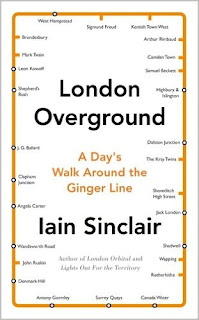Walkers navigate by sound. Drifting towards the Thames with no purpose beyond getting away from the construction dust and promotional screech to the east, I found myself eavesdropping on the climactic moan of the Overground. If the traffic ditch of Kingsland Road played like a gurgle of peristaltic juices recovering from a monster kebab, the Overground was a 14-hour sigh of mounting, but never-quite-satisfied sexual bliss. The heartbeat of the new London might be revealed, I felt, by tracking the acoustic footprints of the railway for a single day: Haggerston to Wapping, Clapham Junction, Imperial Wharf, Willesden Junction, Hampstead Heath and home again. The 33 stations of this perverse pilgrimage, stitched together in ways that had never been possible before, had their own microclimate. The arches beneath the elevated tracks, oil pits dealing in MOT certificates, mysterious lock-ups and rehearsal spaces for bands without names, were being rapidly upgraded to fish farms offering meditational aids to keep money-market buccaneers on an even keel, Japanese restaurants and artisan bakeries operated by downsizing hedge-fund managers. The word “artisan” signalled the change in demographic. A humble medieval craftsperson is upgraded to a purveyor of ethical coffee in a space that tries to look like a newly excavated ruin.
The intriguing aspect of London Overground, beyond parasitical clusters of new-build flats with their bicycle-rack balconies, beyond early-morning gyms and proliferating coffee outlets, was the fact that the system worked. Trains arrived every few minutes, carriages were nicely appointed in colours reminiscent of Penguin books in their pomp. Freshly carved neural pathways made it possible to ride from Dalston to Denmark Hill; to visit Goldsmiths college by way of New Cross Gate; to see where William Blake was married or where Freud died. Any commute, for the honeymoon period before the line caught on, was a rare London pleasure.
A walk around this accidental remapping of London in a single day; that’s what it had to be. If it could be managed. And if Andrew Kötting, the filmmaker and performer, could be persuaded to join me. As foil, informant, partner in absurdity. The journey would be potentially endless, linking prisons, football stadiums, waste-disposal plants, cemeteries and reservoirs of memory. Andrew’s anecdotes of Deptford would sustain us until we arrived at Angela Carter’s Clapham and the location for JG Ballard’s Millennium People in Chelsea Harbour. We must plod on, day into night, waiting to see if a shapely story would emerge
Wednesday, 18 November 2015
Iain Sinclair: London Overground: A Day's Walk Around the Ginger Line
Labels:
Iain Sinclair,
London,
Psychogeography,
UK,
Walking
Subscribe to:
Post Comments (Atom)



No comments:
Post a Comment